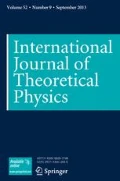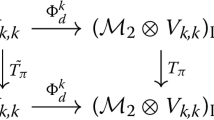Abstract
We propose a noncommutative version of the Euclidean Lie algebra E 2. Several types of non-Hermitian Hamiltonian systems expressed in terms of generic combinations of the generators of this algebra are investigated. Using the breakdown of the explicitly constructed Dyson maps as a criterium, we identify the domains in the parameter space in which the Hamiltonians have real energy spectra and determine the exceptional points signifying the crossover into the different types of spontaneously broken PT-symmetric regions with pairs of complex conjugate eigenvalues. We find exceptional points which remain invariant under the deformation as well as exceptional points becoming dependent on the deformation parameter of the algebra.
Similar content being viewed by others
References
Dey, S., Fring, A., Mathanaranjan, T.: Non-Hermitian systems of Euclidean Lie algebraic type with real eigenvalue spectra. Ann. Phys. 346, 28–41 (2014)
Turbiner, A.: Lie algebras and linear operators with invariant subspaces. In: Kamran, N., Olver, P.J. (eds.) Lie Algebras, Cohomologies and New Findings in Quantum Mechanics, Contemp. Math. AMS, vol. 160, pp. 263–310 (1994)
Assis, P.E.G., Fring, A.: Non-Hermitian Hamiltonians of Lie algebraic type. J. Phys. A 42, 015203 (23p) (2009)
Assis, P.E.G.: Metric operators for non-Hermitian quadratic su(2) Hamiltonians. J. Phys. A 44, 265303 (2011)
Bender, C.M., Kalveks, R.J.: Extending PT symmetry from Heisenberg Algebra to E2 Algebra. Int. J. Theor. Phys. 50, 955–962 (2011)
Jones-Smith, K., Kalveks, R.J.: Vector models in PT quantum mechanics. Int. J. Theor. Phys. 52, 2187–2195 (2013)
Musslimani, Z.H., Makris, K.G., El-Ganainy, R., Christodoulides, D.N.: Optical solitons in PT periodic potentials. Phys. Rev. Lett. 100, 030402 (2008)
Makris, K.G., El-Ganainy, R., Christodoulides, D.N., Musslimani, Z.H.: PT-symmetric optical lattices. Phys. Rev. A 81, 063807(10) (2010)
Guo, A., Salamo, G.J., Duchesne, D., Morandotti, R., Volatier-Ravat, M., Aimez, V., Siviloglou, G.A., Christodoulides, D.: Observation of PT-symmetry breaking in complex optical potentials. Phys. Rev. Lett. 103, 093902(4) (2009)
Midya, B., Roy, B., Roychoudhury, R.: A note on the PT invariant potential 4c o s 2 x + 4i V 0 s i n2x. Phys. Lett. A 374, 2605–2607 (2010)
Jones, H.: Use of equivalent Hermitian Hamiltonian for PT-symmetric sinusoidal optical lattices. J. Phys. A 44, 345302 (2011)
Graefe, E., Jones, H.: PT-symmetric sinusoidal optical lattices at the symmetry-breaking threshold. Phys. Rev. A 84, 013818(8) (2011)
Longhi, S., Della Valle, G.: Invisible defects in complex crystals. Ann. Phys. 334, 35–46 (2013)
Wigner, E.: Normal form of antiunitary operators. J. Math. Phys. 1, 409–413 (1960)
Bender, C.M., Boettcher, S.: Real spectra in Non-Hermitian Hamiltonians having PT symmetry. Phys. Rev. Lett. 80, 5243–5246 (1998)
Bender, C.M.: Making sense of non-Hermitian Hamiltonians. Rep. Prog. Phys. 70, 947–1018 (2007)
Kato, T.: Perturbation Theory for Linear Operators. Springer, Berlin (1966)
Heiss, W.D.: Repulsion of resonance states and exceptional points. Phys. Rev. E 61, 929–932 (2000)
Rotter, I., Exceptional points and double poles of the S matrix. Phys. Rev. E 67, 026204 (2003)
Günther, U., Rotter, I., Samsonov, B.F.: Projective Hilbert space structures at exceptional points. J. Phys. A: Math. Theoret. 40(30), 8815 (2007)
Scholtz, F.G., Geyer, H.B., Hahne, F.: Quasi-Hermitian operators in quantum mechanics and the variational principle. Ann. Phys. 213, 74–101 (1992)
Mostafazadeh, A.: Pseudo-Hermitian representation of quantum mechanics. Int. J. Geom. Methods Mod. Phys. 7, 1191–1306 (2010)
Acknowledgments
SD is supported by a City University Research Fellowship. TM is funded by an Erasmus Mundus scholarship and thanks City University for kind hospitality.
Author information
Authors and Affiliations
Corresponding author
Rights and permissions
About this article
Cite this article
Dey, S., Fring, A. & Mathanaranjan, T. Spontaneous PT-Symmetry Breaking for Systems of Noncommutative Euclidean Lie Algebraic Type. Int J Theor Phys 54, 4027–4033 (2015). https://doi.org/10.1007/s10773-014-2447-4
Received:
Accepted:
Published:
Issue Date:
DOI: https://doi.org/10.1007/s10773-014-2447-4



